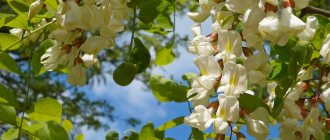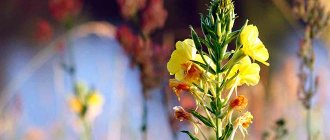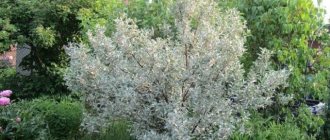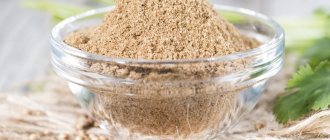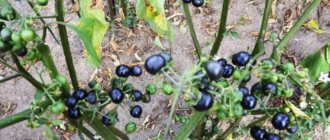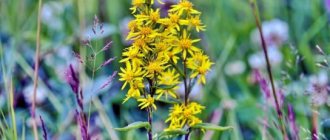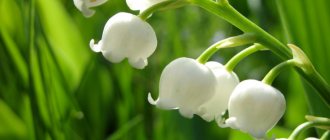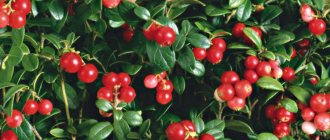Chemical composition
The most useful part of this plant is the root. It is rich in valuable chemicals that give Badan medicinal properties.
- Ascorbic acid;
- Glucose and other sugars;
- Bergenin isocoumarin;
- Starch;
- Polyphenols.
About a third of the roots are tannins.
There are other components found in the foliage, of which the third part is tannins.
- Tannins;
- Vitamins of group C;
- Coumarins;
- Flavonoids;
- Carotene;
- Copper, manganese and iron ions;
- Gallic acid.
The plant is rich in essential oils.
Where to buy seeds
This plant is very popular, so it will not be difficult to purchase seeds, divisions and cuttings. Plant seeds can be bought from specialized stores, ordered online, or by mail via semenapost
| Variety name | Where do they sell it? | Price |
| Baban (all varieties) | Nursery Green lines (divisions) | 200 rub. For 5 pieces. |
| Rose budan seedlings | Nursery | 150 rub. For 5 pcs. |
| Bergenia Cordifolia, Plasma | Online store | 23r. package. |
| Badan Maestro mix | "Garden Express" online store | 31r. per pack |
The healing properties of elephant ears
All parts of Badan are used for medicinal purposes. The plant is used to provide various effects.
- Antipyretic;
- Antibacterial;
- Anti-inflammatory;
- Diuretic;
- Healing;
- Anti-stress;
- Antitumor;
- Antimicrobial and hemostatic (from leaves).
Tablets are made from the roots to treat diseases of the uterus and oral cavity. In folk medicine, the use of this remedy is wider.
- Hypertension;
- Pneumonia, pulmonary tuberculosis;
- Pain in the head area;
- Diarrhea, gastrointestinal diseases;
- ENT diseases;
- Rheumatism;
- Kidney diseases.
Combination with other plants
Plants that bergenia does not combine with are lily of the valley, periwinkle, sedge. Low plants that reproduce by creeping rhizomes cannot coexist next to bergenia. They simply interfere with each other.
If the flowerbed is located in the shade or partial shade, then excellent neighbors:
Bulbous plants go well with bergenia:
After flowering, bulbous plants lose their special attractiveness. Bergenia, growing, covers all available space and the flowerbed does not lose its well-groomed appearance.
Pink bergenia flowers go well with small blue scylla and forget-me-not flowers. It looks cute and romantic. Scylla wakes up early after winter; in tandem with frost-resistant bergenia, they are the first to decorate the garden and notify everyone about spring. The green perennial is unpretentious, which allows it to be combined with many plants, including annuals.
Types and varieties in them
On average, Badan has about 10 species. Representatives of different varieties can differ greatly from each other. Below are the types that are most popular among gardeners.
Badan Strechi
In the wild, it is found in Central Asia, the Himalayas, Afghanistan and China, and can grow at altitudes of up to 3,000 kilometers above sea level. The foliage does not exceed 5 centimeters in width and 10 centimeters in length. It can survive even under a layer of snow. The height of the plant is usually 40 centimeters. A brush with white or pink flowers one and a half centimeters long is formed on top. Flowering occurs in the second half of summer. The most popular varieties: Belvedere, Beethoven and Alba.
Bergenia thickleaf
Another name for this species is medicinal. In the wild it is found in Korea, China, Kazakhstan, Transbaikalia and the northern part of Mongolia. Preferred terrain is cedar forests, rocky slopes at high altitudes (700-2500 kilometers above sea level).
The root system is powerful and creeping. White, purple, lilac-pink flowers are collected in fairly lush inflorescences. The leaves are rich green and turn fiery red in the fall. The following varieties have gained fame: Senor, Purpurea, Hydroruspe.
Bergenia cordifolia
This variety is a variation of the previous species; its height usually reaches 40 centimeters. The round, dark green leaves feel rough to the touch. At the end of spring, inflorescences appear, consisting of flowers from bright pink to pale lilac shades.
Badan Gissar
The rhizome of this rare species is powerful. The leaves are oblong, matte, densely ciliated at the edges. The peduncle grows up to 20 centimeters long. In this case, an inflorescence of 6-8 white flowers, sometimes pale pink, is formed.
Bergenia hybrid
This species includes elephant ear hybrids. The most popular types: Abenglut, Frau Holle, Baby Dople, Schneekenigin, Morgen Rothe.
Popular types of bergenia
There are more than 10 varieties of bergenia, but only a few are common:
- Hidenuspe. Up to 60 cm in height, the plant produces soft pink inflorescences up to 20 cm, where each bergenia flower is no more than 1 cm. It blooms in April.
- Purpurea. Bergenia up to 50 cm with purple flowers in inflorescences up to 15 cm, 1 flower - 1 cm. Flowering lasts up to 50 days from May.
In the gardens they grow: Siberian, Pamir, Himalayan and Chinese bergenia.
Features of garden care
Caring for the plant is quite simple - it is unpretentious. It is important to remember that Badan dies on dry soil; you need to maintain soil moisture. Watering - abundant, regular. It is not recommended to remove the lower leaves that have lost their beautiful appearance. Thanks to them, the plant retains moisture. As a last resort, after removal it is necessary to lay mulch around the trunk.
Typically, flowering occurs in the second half of spring, it all depends on the specific species and variety. If you don't want the seeds, you can carefully trim off the dead fronds and carefully pull off the dead leaves in the fall. Proper care and good conditions will lead to re-blooming in late summer and early spring. Bergenia grows strongly, thereby eliminating weeds from the territory.
Bergenia does not need regular feeding with fertilizers; it is enough to add highly diluted complex minerals once after the flowering period. It is often not recommended because excess fertilizer can lead to poor plant growth.
It is not recommended to organize transplants, as Badan is difficult to tolerate relocation. Bergenia lives best in one place and lives like this for up to 12 years. As the plant grows and develops, it increases in width. During planting, it is necessary to take some distance and limit the space of the flower so that other residents of the garden do not suffer.
Disembarkation time
Planting and growing this plant turns out to be quite simple due to Badan’s unpretentiousness and resistance to frost.
- Seedlings are planted in early August;
- Some experts recommend doing this in early June without picking. But in fact, by this time the seedlings are still too weak and do not survive in open ground. So it is better to plant only mature and strong shoots at the beginning of summer.
Using bergenia in landscape design
Bergenia has an original outline of the bushes, bright colors, interesting shapes of leaves and inflorescences, which allows it to be used in picturesque compositions. In Russia it is not often found on private plots. But, given the huge number of advantages of bergenia (perennial, evergreen, frost-resistant), the demand for it will only increase.
Important! In order to preserve the decorative characteristics of the bush as much as possible, it must be covered for the winter. For this you will need rotted leaves, pine needles and straw.
Design tricks
Bergenia is not only a beautiful plant, but also capable of hiding unsightly parts of the site. The plant grows very quickly, the stems densely fill the area in a short period of time, thereby leaving no chance for the spread of weeds. Thanks to this, you can hide some unsightly elements (well hole, cracks in the curb, etc.).
The plant performs best in large flower beds where many other ornamental crops are planted. Bergenia creates contrast with its bright and rich color. Next to it, all neighboring plantings will take on a new and interesting look.
What plants go well with in the flowerbed?
One of the main advantages of bergenia is that it has a decorative appearance for a long period: from early spring to late autumn. Often culture occupies the main place in the style of the garden. For example, in the spring, among irises, phlox, asters, daylilies, bells and many other flowering plants, these shrubs stand out for their rich color and numerous inflorescences. In autumn, bergenia also comes to the fore among other participants in landscape design, as the leaves acquire various shades characteristic of this period.
Did you know? Bergenia has a huge number of medicinal properties. It is especially recommended to take it in the form of tea for diseases of the intestinal tract.
Culture looks organically in landscapes that imitate natural conditions: in rocky gardens, near streams, ponds, on alpine hills. It is an excellent combination both in group compositions and in single plantings. There are a lot of options for using bergenia, since the plant is not afraid of partial shade conditions, which allows it to be planted under trees and near large bushes.
Culture has a unique feature of being organically combined with architectural objects. Against the backdrop of brickwork, garden fences and natural stone, shrubs will look very beautiful.
Planting technology with other colors
Bergenia is unpretentious in the neighborhood, so it can be planted with almost any plants in the garden. Landscape designers do not recommend combining this shrub with sedge, lily of the valley or periwinkle. They don't fit together and don't look harmonious next to each other. For example, in any composition with other flowers, choose the north, northeast or northwest side for the incense. In well-lit areas, the plant may have a slightly depressed appearance and weak bushes. The place should be rocky, with well-drained soil.
Important! Gardeners need to take into account that this crop grows very quickly. The seating area should be spacious.
The algorithm of actions during landing is as follows:
- Dig a hole 30x30 cm. It is necessary to create natural conditions for the plant in it, add a mixture of soil and stones.
- Place a thick layer of broken bricks at the bottom of the hole.
- Next, carefully immerse the root system of the seedling.
- Fill the hole with a mixture of turf soil, small pebbles and sand in a ratio of 1:2:2.
- Water the plant generously.
Video: planting bergenia
Growing a perennial plant
Most often, seeds are chosen for planting Badan.
Growing bergenia from seeds
Seeds are planted in winter.
- A box or other container is filled with a special soil mixture for flowers;
- Make shallow grooves, about half a centimeter. The distance between is three centimeters;
- Water the grooves with warm water;
- The seeds are carefully laid out and covered with earth;
- The box is buried in the snow in the garden;
- At the beginning of summer, the box is taken out and taken to a cool room.
Growing seedlings
Sprouts appear in the next three weeks. When the top layer of soil dries out, you need to promptly water the plants. The soil must be constantly loosened and the room ventilated. Plants are thinned out.
Excessive watering causes a greenish crust to appear on the surface of the soil. You need to immediately loosen the soil to supply oxygen to the roots.
Beneficial features
In Europe, bergenia is known primarily as an ornamental plant. However, in Mongolia, Buryatia, Altai and other regions of Asia, it is known primarily as a perennial from which tea is made.
- The drink helps with many ailments, for example, in the following cases:
- cleanses the body, removing toxins and free radicals;
- helps with gastrointestinal diseases, especially stomach and duodenal ulcers;
- promotes the destruction of pathogenic microorganisms in the intestines;
- suppresses inflammatory processes in the body;
- has a mild diuretic and hemostatic effect.
Bergenia should be planted in your own garden not only because of its attractive appearance, but also because it is an absolutely unpretentious plant. Thanks to its beautiful flowering and large leaves, it combines with many garden plants, loves places near water bodies and is suitable for creating landscape compositions.
Landing Features
Bergenia can be planted in any region of Russia, but in the south of the country and in drier parts it will be a little more difficult to care for - more frequent watering will be required. In such situations, it is better to plant Badan in semi-shady places.
Planting bergenia in open ground
Opinions about the landing site are divided. Some people think that it is better to plant in the sun, others believe that it is better in partial shade so that the soil does not dry out too quickly. The choice remains with the gardener who decides to plant Badan. In hot places, it is better to choose not only partial shade, but also plant closer to moisture - for example, near a pond or lake.
The soil should be light so that there is a constant flow of oxygen to the roots. The soil around the plant needs to be mulched due to the shallow root system. Otherwise, the sun will burn the rhizome and the plant will die. It is better to avoid excess moisture.
Picking seedlings
Seedlings dive in the last month of spring. The sprouts are transplanted into a larger container; there should be a distance of approximately 5-7 centimeters between them within the row, and 15 cm between the rows.
Two weeks before planting in open ground, you need to start hardening off the plants. Every day you need to take the seedlings outside, gradually increasing the duration of their stay in the fresh air. When the duration of being outside reaches a day, the seedlings can be planted.
Planting bergenia in a flowerpot
Bergenia growing in a pot will not only make a good decoration, but will also be convenient to grow. So, you can move it to any place you like without damaging the plant. To disembark, you must follow the following instructions.
- Place drainage at the bottom of the container to a quarter of the total volume (pebbles, crushed stone, expanded clay are suitable);
- Fill half the volume with soil mixture (part sand and part compost, two parts turf and leaf soil);
- Carefully plant the bush in the center, sprinkle with the rest of the mixture;
- Lightly compact the soil;
- Water;
- Mulch the soil.
Dishes for plants should have high-quality holes for drainage. To prevent them from becoming clogged with soil mixture after watering, you need to lay the shards up to the drainage layer.
Bergenia care
Bergenia thickleaf feels great in the shade and in light areas, but will not grow in the sun. Annual transplants are contraindicated; this will lead to diseases and depletion of bergenia.
The unpretentious plant loves rocky soil, except on the south side. Loves nutritious light soil, no need to fill it.
Bergenia thick-leaved is used for home decoration, and as a cure for many diseases, after long soaking it is suitable for food.
Reproduction
There are several ways to propagate Badan.
Dividing the bush
In addition to planting seeds, there is another way - dividing the bush. After Bergenia fades (May-August), division needs to be done. Only healthy specimens are used. You need to dig out the bush carefully, taking into account that the root system is close to the surface.
The separated parts are planted in holes dug in advance. Plants are buried 3-5 centimeters into the soil. The permissible distance is 30-40 centimeters. The branches will bloom in the second or third year; in the new soil they take root quite quickly and form gorgeous foliage.
Division by rhizome segments
At the beginning of autumn, you need to carefully dig up the ground, cut off pieces of roots (15-20 centimeters is enough). Each particle must have at least three buds. Choose a new place for planting, make the grooves not very deep, the distance between them is about 30 centimeters. The roots are laid horizontally and sprinkled with a little soil mixture on top. After this, you need to water the ground and lay mulch.
Division by sockets
The propagation period by this method is from the end of flowering to the beginning of autumn. The rosettes are carefully removed from the mother's body, after which they are planted in the selected area. For work, select a sharp knife and treat it with alcohol. Wipe the cut areas with ground charcoal.
The holes are 30 centimeters deep and 30-40 centimeters apart. It is imperative to lay drainage layers to eliminate the risk of rotting. After planting, the plants need to be carefully watered and covered with a layer of mulch.
How to care for a plant in open ground
Proper care will give the unpretentious bergenia even greater aesthetics
It is important to carry out all agricultural practices correctly
How often to water?
One of the important care measures is high-quality watering. Bergenia needs abundant irrigation at the time of budding and flowering. In the future, water only when there is no precipitation. In rainy weather, irrigation should be avoided.
Fertilizing and loosening the soil
Bergenia is responsive to well-chosen fertilizers. The crop needs to be fertilized before and after flowering using mineral fertilizers. This will help stimulate further growth of the perennial. To restore reserves of nutrients and accelerate the growth of rosettes, after the inflorescences have withered, the bushes need to be fed again.
Formation of bushes
Many gardeners are interested in whether they need to prune bergenia. The formation of bushes is carried out in early spring and includes:
- checking the integrity of the roots and the presence of growth buds;
- cleaning of dry leaves and last year's inflorescences;
- pruning excess shoots, leaving only independent bushes.
Pest and disease control
Diseases overwhelm bergenia due to lack of attention. Healthy bushes are resistant to diseases and pests. Fungus and rotting of the root system can be dangerous. These problems arise due to increased soil moisture. Control measures include pruning and burning the affected parts.
Of the pests that can attack perennials, weevils are the most insidious. The beetles themselves are not as dangerous as their larvae, which feed on the roots of the flower. To combat it you need to use special chemicals. And as a preventative measure, in the spring, remove all darkened foliage, since weevils hibernate under it.
Perennials can also be attacked by slugs, nematodes and slobbering pennies. The bushes affected by them should be dug up and destroyed to prevent spread, and the flowerbed where they grew should be treated with insecticides.
Transfer
Bergenia reacts negatively to frequent transplants. The perennial grows strongly and shows aggression, taking over territory intended for other crops, and therefore requires replanting to new places every 6 years. To do this, transplant the flower in September using the method of dividing the bush. Plant parts of the plant, keeping a distance of at least 30 cm between them. It must be taken into account that with frequent transplants, the plant will not have time to recover, will look depressed and often get sick.
Important! Uncontrolled spreading of plantings will provoke their excessive density, which leads to the emergence of diseases and insect infestations
Preparing and wintering garden bergenia
A change in the color of bergenia leaves is a signal of the first frost. This phenomenon indicates that the plant has begun to accumulate sugar in its tissues, which will provide the bushes with a favorable winter. For each type of crop, the leaves turn red differently - in some, a yellow border forms along the edge of the leaf plate, which becomes saturated with cold weather, in others, a colorful pattern of streaks spreads across the leaf, in others, the foliage immediately acquires a crimson color.
Thanks to the huge supply of sugar, the perennial is not afraid of cold winters. The main condition is not to cut off its wilted leaves in the autumn, as they will serve as natural protection from the cold.
It is important to prepare young plants for winter by covering them with spruce branches.
Diseases and pests
Bergenia has good immunity and resistance to many diseases and parasites.
However, when water stagnates, the plant becomes infected with a fungal disease - ramulariasis. A white coating appears on the inside of the leaves, and dark brown spots with a red edge appear on the outside. The foliage gradually dries out and the plant dies. The affected leaves must be removed and the bush sprayed with a fungicide containing copper. If the plant is planted in the shady part, then nematodes and pennies can easily settle on it. To poison the latter, you need to spray the bush with Aktara, and repeat after a week. For processing, you need to choose a dry day with a temperature in the sun in the range of 21-28°C.
To rid Badan of nematodes, you need to transplant the affected bush from the soil into a strong solution of potassium permanganate for half an hour. The plant is planted in a new place. The contaminated soil is subjected to a series of insecticide treatments. It will be possible to plant anything in this area only after a year.
Problems during cultivation and care
Why does the plant not produce inflorescences?
Flowering in bergenia is delayed under the following conditions:
- The plant is young. The main reason why bergenia does not bloom is growing from seeds; the chosen propagation method is accompanied by late flowering: in the third or fourth year after sowing, you should wait a little.
- Flowers are densely planted. It is advisable to plant bergenia.
- The crop has been recently or frequently replanted - an additional reason why bergenia bushes do not bloom. What to do? Wait until the plant adapts to the new place, provide comprehensive feeding with minerals.
- Not enough light. A similar situation is possible if you shade the bushes with old trees with wide crowns.
The plant does not bloom
Bergenia does not produce color when infected with fungus. Growing a flower in wetlands and constant moisture results in diseases that affect the leaves and peduncles.
The leaves are curling
Leaf deformation is often caused by gaps in care:
- if planted incorrectly;
- ensure nutritional deficiencies;
- lack of moisture;
- sudden changes in temperature;
- fail to prevent pest attacks;
- diseases.
Determining the problem begins with a careful examination of shoots and leaves, analysis of weather conditions, and care actions.
Pest and disease control
The peculiarities of the chemical composition allow bergenia to easily cope with pest attacks. However, in clayey soil or poor drainage, the rhizome is susceptible to rotting. Crops grown in the shade are attacked by the slobbering pennitsa. The perennial is also attacked by nematodes; fighting earthworms will not be difficult if you treat the rhizomes with a manganese solution. Then a transplant to a new place will be required. Areas attacked by nematodes are disinfected with chemicals.
Bergenia after flowering
Collecting seeds
After flowering ends, the bush produces many seeds 2 millimeters in size. While Bergenia is blooming, choose the best inflorescence, and when the flowers begin to gradually fade, put on a gauze bag. This way, you will not lose the seeds from this box.
In September the seeds are collected. The inflorescences are trimmed and transferred to a dry room with good ventilation. After a few weeks, when parts of the plant have completely dried out, shake out the seeds. Afterwards, the material is removed for storage.
Preparing for winter
Varieties that are not resistant to frost should be covered in the fall with spruce branches or fallen leaves.
How to care for a plant in open ground
Growing and caring for bergenia does not require special attention; the flower is not at all capricious. The main thing is to keep the soil moist and loose.
Bergenia loves loose, fertile soil where there is no stagnation of moisture. The acidity level should be reduced. Alkalinity, on the contrary, is slightly overestimated. You can add a little lime to the soil to increase the alkalinity level.
On rainy days, the shrub does not require watering
During dry periods, it is important to give the flower enough moisture, otherwise it will get sick. Irrigation water should be at room temperature, cold water promotes stagnation of moisture and the formation of fungal diseases
The first time after planting, it is important to provide special care to the bergenia. Watering for the first time is carried out only after the formation of the first buds, the next time - at the very peak of flowering, the third watering - when all the buds have faded
Periodically you need to carefully loosen the soil, trying not to damage the soil.
During the flowering period, there is no need to disturb the bush once again.
In spring and autumn, it is necessary to remove rotten and dried leaves, stems and buds. In the spring, mineral fertilizers are applied, and in the fall, organic and mineral fertilizing is done.
During flowering, care is suspended, which will disturb and injure the bush. During this period, it is necessary to monitor the lighting of the bushes - it should be moderate. Bergenia blooms well in lighted areas.
Important! It is extremely necessary to avoid strong drafts during flowering. The plant is very frost-resistant, so it does not need shelter.
However, flower growers notice that after winter covering with spruce branches, bergenia blooms more profusely, begins to grow faster and awakens sooner after wintering
The plant is very frost-resistant, so it does not need shelter. However, flower growers notice that after winter covering with spruce branches, bergenia blooms more profusely, begins to grow faster and awakens sooner after wintering.
How to prepare and store raw materials
Rhizomes and leaves are harvested separately.
Roots
When the bergenia fades, you can dig up the rhizome. This should begin at the end of June. The roots are washed, finely chopped, and then dried outside or in a dryer (temperature does not exceed 30°C). Drying lasts about a month. Store the roots in a container with a tightly closed lid. Properties can be maintained for 3 years.
Leaves
The leaves are dried on a thin layer of paper or wood. The required temperature is 30°C. The resulting material is stored in a paper bag or glass jar. It is necessary to limit access to moisture. Storage reaches 3 years.
Origin
Bergenia is a perennial herbaceous plant that grows wild in Central and East Asia. It belongs to the genus of the same name, which, in turn, belongs to the Saxifraga family. Bergenia received its Latin name bergenia in honor of Karl August von Bergen, a German botanist and doctor of medicine who lived in the 18th century.
Saxifraga thick-leaved - the first name of the plant
Bergenia became known to science after 1760 , when the Swedish physician and naturalist Carl Linnaeus received a sample of an unstudied Siberian plant from the Imperial Botanical Garden of St. Petersburg. It received the name “saxifrage thick-leaved” and was known under this name for a long time, until the German professor of botany and opponent of Carl Linnaeus Conrad Mench identified it as a separate genus.
Cosmetology
Bergenia can help with skin imperfections, acne, dermatitis, and oiliness. This can be removed with alcohol tincture. To do this, pour a tablespoon of root with half a glass of alcohol and leave in a dark place for six days.
Use tincture for a compress or lotion. Do it twice a week for a quarter of an hour. After this, wash with cool, purified water.
The decoction helps strengthen hair and get rid of dandruff. After washing your hair, you need to rub the Badan decoction into the scalp with massaging movements.
Arranging daylilies in the garden
A flowerbed with daylilies can look completely different (see diagrams).
When placing daylilies in your garden plot, you should know:
Low-growing plants are used for landscaping the alpine hill. The varieties used are Eenie Winnie and Longfield Glory. It is advisable to plant fragrant varieties of Siloam Double Classic near benches and gazebos. During the flowering period, the culture is in no way inferior to exquisite roses, but requires very little attention during the growing process. Daylilies of the varieties Outrageous, Galaxie Barogue and Always Prestnt, which look unsurpassed, will help decorate the walls. The ideal option is a combination with other varieties of relatives. A flower bed of irises and daylilies will help add color to the area, hide a certain defect in the wall or fence - simplicity and sophistication “in one bottle”
Tall daylilies are usually planted in the background of a flower bed or in its center, specifically focusing attention on the plant. Decorating your garden paths with a combination of tall and short varieties of daylilies is easy. Large bushes are planted for the background, and low-growing specimens are planted to emphasize the lines of the garden path.
When creating compositions, you should select varieties not only by the size of the peduncles, but also by the color of the buds. Against the background of a red brick wall, a yellow daylily looks extravagant, and a bush with dark or bright blooms will complement the light facade.
Daylilies are amazing plants that can be combined with all flowers, regardless of size and color. The beauty of bushes is that they look decorative at all times of the year.
Traditional medicine recipes
Various potions can be prepared from the roots and leaves of Bergenia.
Medicinal tea
Badan tea improves blood pressure and normalizes the functioning of the gastrointestinal tract.
- Dried leaves are placed in a container (a tablespoon);
- Half a liter of boiling water is poured there;
- Let it brew for twenty minutes.
You need to drink it in the morning on an empty stomach.
Infusion
The recipe is simple.
- Place a tablespoon of dried root and leaves in a container;
- Pour boiling water over;
- Leave for two hours.
Take two tablespoons several times a day.
Extract
The extract improves overall well-being, moisturizes the body and has a preventive effect against many diseases.
- Two tablespoons of root are poured into 0.2 liters of boiling water;
- Bring to a boil over low heat, cover with a lid;
- Boil until half the solution evaporates;
- The broth is filtered.
Drink 30 drops every day.
Fertilizer and fertilizing of bergenia
The plant is very responsive to properly selected fertilizing. Before and after bergenia blooms, it is recommended to use mineral fertilizers. 2-3 weeks after flowering, you can feed the plant: fertilizers in this case activate the process of growing and aging of the leaves, which at this time are just beginning to change their color.
The plant should be fed with mineral compounds
How to grow bergenia
Bergenia loves moist soil, which should not be acidic. It is preferable to choose a slightly alkaline one.
Bergenia is planted in the fall. The most favorable period is considered to be the end of September and the first ten days of October.
The planting technique is as follows: a large rhizome (together with the above-ground leaf part) is divided into parts and planted in pre-prepared holes.
The landing site is well moistened. To do this, the hole is filled with water. The delenka is placed in a hole with water and covered three-quarters with soil. Trying not to damage the root system, the soil is compacted, spilled again and only then the soil is added. This will make it easier for the plant to survive the transplant.
The most difficult period for plant rooting is the first summer season. The roots will not grow, and perhaps the bush will not bloom. Bergenia will delight you with lush flowers only in the third year.
If you plant several bushes in a row, then the gap between them should be about half a meter. This measure is necessary so that the bergenia root can fully develop and enlarge.
The plant is frost resistant. Although certain types of bergenia and young bushes can freeze in extreme cold and in winters with little snow. To preserve the plant for sure, in the fall you can cover the bush with dry leaves or cover it with spruce branches.
There are varieties adapted to harsh climates; if these are the ones planted on the site, then there is no need to worry - the plant will not die.
Advice: there is no need to trim old leaves before winter; the plant will overwinter better with them. You can tidy up the bush in the spring.
Contraindications
The value of bergenia is obvious, but everything is good in moderation. Therefore, when starting to use products that contain a medicinal drug, you need to familiarize yourself with the contraindications.
If infusions and decoctions are taken for a long period of time, the normal functioning of the intestines can be disrupted and constipation may occur.
Under no circumstances should you take products that contain the plant if the patient has increased blood clotting.
Hypotonic people should also drink grass with caution - blood pressure can drop quite significantly.
